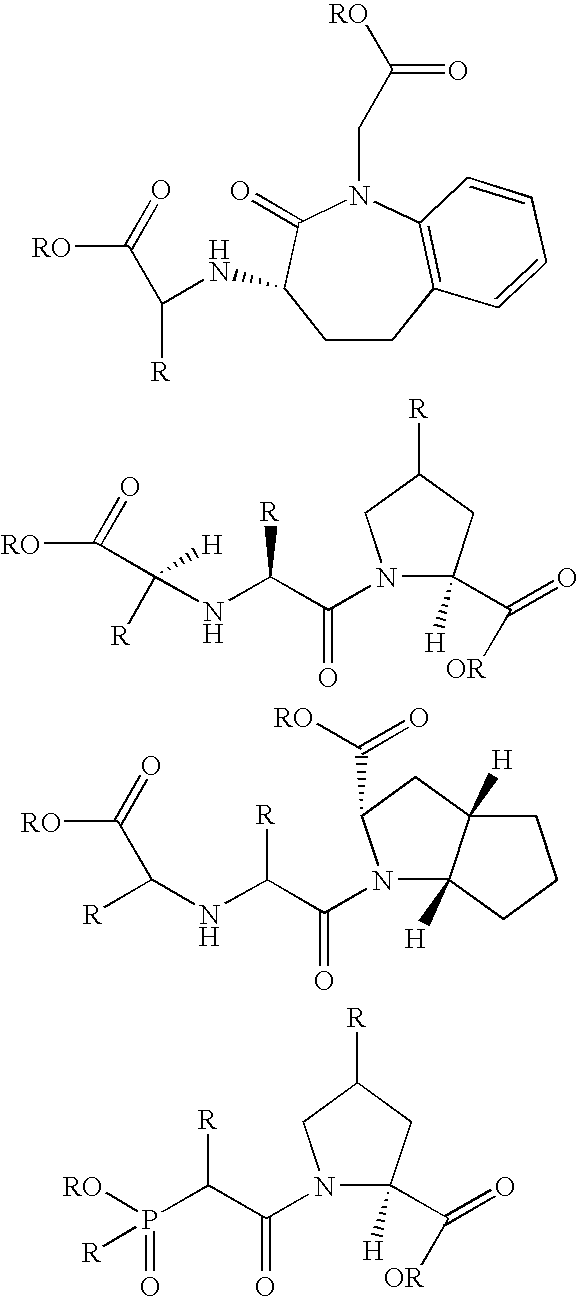Novel compounds that inhibit dipeptidyl peptidase (DPP-IV) and neprilysin (NEP) and/or angiotensin converting enzyme (ACE)
a technology of dipeptidyl peptidase and dipeptidyl peptide, which is applied in the direction of boron compound active ingredients, heterocyclic compound active ingredients, biocide, etc., can solve the problems of blood glucose levels staying abnormally high and severe health problems
- Summary
- Abstract
- Description
- Claims
- Application Information
AI Technical Summary
Problems solved by technology
Method used
Image
Examples
example 1
[0044]
(2-Hydroxyethylamino)-acetic acid
[0045] Chloro acetic acid (11 g, 116 mmol) was added dropwise to a solution of ethanolamine (17.6 mL, 292 mmol) in water (14 mL). After stirring for 24 h at rt, the solution was evaporated and the product crystallised with ethanol. The crude product was recrystallised from ethanol / water.
[0046]1H-NMR (300 MHz, D2O) 3.76 (dd, J=5.25 Hz, 2H); 3.56 (s, 2H); 3.12 (dd, J=5.25 Hz, 2H); MS—(M−H+) 120.3.
[tert-Butoxycarbonyl-(2-hydroxyethyl)-amino]-acetic acid
[0047] Di-tert-butyl-dicarbonate (6.83 g, 31.3 mmol) was added to a solution of (2-hydroxyethylamino)acetic acid (3.39 g, 28.4 mmol) in 1 N NaOH (28.4 mL, 28.4 mmol), water (28.4 mL) and dioxane (56.8 mL). After stirring for 24 h at rt, the solution was partially evaporated, acidified with 1 N HCl (pH 1) and extracted several times with ethyl acetate. The combined organic layers were dried over MgSO4, filtered and evaporated.
[0048]1H-NMR (300 MHz, CDCl3) 1.42, 1.45 (d, 9H,); 3.45, 3.64 (m, 2H,)...
example 2
[0070]
2-tert-Butoxycarbonylamino-glutaric acid-5-ethyl ester
[0071] L-Glutamic acid-5-ethylester (5.4 g, 30.8 mmol) and di-tert-butyl-dicarbonate (8.1 g, 37 mmol) were suspended in methanol (42 ml) and triethylamine (5 ml) and warmed to 45° C. until everything is dissolved. The solution was then stirred for 30 min at rt and concentrated in vacuo. The residue was dissolved in water, acidified with 10% aq. sodium hydrogen sulfate solution and extracted several times with ethyl acetate. The combined organic layers were dried over MgSO4, filtered and evaporated.
[0072]1H-NMR (300 MHz, CDCl3) 9.56 (bs, 1H), 5.25 (bd, 1H), 4.35-4.34 (m, 1H), 4.13 (q, 2H), 2.49-2.38 (m, 2H), 2.26-2.2 (m, 1H), 2.05-1.98 (m, 1H), 1.45 (s, 9H), 1.26 (t, 3H)
[0073] MS—(M−H+) 276.5; (M−H−) 274.5
4-tert-Butoxycarbonylamino-5-(2-carbamoylpyrrolidin-1-yl)-5-oxopentanoic acid ethyl ester
[0074] 2-tert-Butoxycarbonylamino-glutaric acid-5-ethyl ester (4.2 g, 15.2 mmol) was dissolved in dichloromethane (50 ml) and coo...
example 3
[0099]
(2-Benzylcarbamoyl-3-phenylpropyl)-(1-tert-butoxycarbonylaminoethyl)-phosphinic acid
[0100] 2-Benzyl-3-[(1-tert-butoxycarbonylaminoethyl)-hydroxyphosphinoyl]-propionic acid (1 g, 2.7 mmol) and benzylamine (0.35 ml, 3.2 mmol) were dissolved in dimethylformamide (20 ml). Then benzotriazol-1-yloxy-tris(dimethylamino)-phosphonium hexafluorophosphate (1.5 g, 3.4 mmol) and triethylamine (0.9 ml, 6.8 mmol) were added and the reaction mixture stirred at rt (reaction control with HPLC-MS). The reaction mixture was diluted with ethyl acetate and washed with 1 N HCl and brine. The combined aqueous layers were saturated with NaCl and extracted several times with ethyl acetate. The combined organic layers were dried over MgSO4, filtered and evaporated. The crude product was purified by column chromatography (silica gel, ethyl acetate, dichloromethane / methanol, methanol).
[0101] MS—(M−H+) 461.8; (M−H−) 459.8
(1-Aminoethyl)-(2-benzylcarbamoyl-3-phenylpropyl)-phosphinic acid hydrochloride
[01...
PUM
| Property | Measurement | Unit |
|---|---|---|
| Electrical resistance | aaaaa | aaaaa |
Abstract
Description
Claims
Application Information
 Login to View More
Login to View More - R&D
- Intellectual Property
- Life Sciences
- Materials
- Tech Scout
- Unparalleled Data Quality
- Higher Quality Content
- 60% Fewer Hallucinations
Browse by: Latest US Patents, China's latest patents, Technical Efficacy Thesaurus, Application Domain, Technology Topic, Popular Technical Reports.
© 2025 PatSnap. All rights reserved.Legal|Privacy policy|Modern Slavery Act Transparency Statement|Sitemap|About US| Contact US: help@patsnap.com



